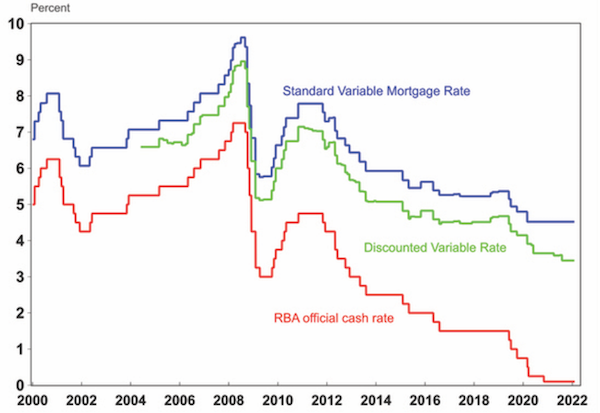
Why have interest rates been so low for so long?
The main reason interest rates have been kept so low is the Reserve Bank of Australia undershooting on its inflation target of 2-3%. We haven’t seen underlying or core inflation within that band sustainably since before 2014.
As well as inflation, a few other factors have kept growth in Australia below trend over the past decade—even before the pandemic.
Mining investment peaked back in 2012 and then after that there was a period of weaker GDP growth. Wages growth has been pretty low as well at about 2% annually when normally it should be closer to 3%.
And there’s also been spare capacity in the labour market with the unemployment rate, while not super high, probably more elevated than the RBA would like.
All these factors have kept downward pressure on rates, in line with the general experience across developed countries.
Do you think interest rates will increase in 2022?
AMP’s view is that interest rates will increase in 2022 for the first time in over 10 years. At the moment we think the first hike will probably be in August and another one in September, and by the end of the year the RBA cash rate will be up to 0.5% from 0.1%.
An earlier rate hike is possible and the earliest it could probably happen is around June. May is complicated by the upcoming federal election as the RBA usually tries to steer clear of any perception it’s influencing political outcomes. So they’ll probably try to wait until the election’s out of the way and also see what’s in the Federal Budget, although this could be a little redundant if there’s a change in government, which appears to be a distinct possibility if you believe the betting odds.
It’s important to remember that even if we do get interest rate hikes this year, the cash rate will still remain pretty low. Next year we expect more rate hikes to take the cash rate to between 1.25% and 1.5% by the end of 2023.
What are the main factors the Reserve Bank will take into account when deciding whether to raise rates?
Like most central banks around the world, the main issue here is inflation, which has been running at a much higher than expected pace.
There are a few reasons for this. The pandemic is causing disruption to supply chains and that’s leading to increases in the price of transporting goods and higher commodity prices.
There’s also been a huge increase in monetary and fiscal stimulus over the past two years, boosting demand for goods and contributing to higher prices.
While the supply chain issues are probably not going to last for ever and should start to ease off by the end of this year, it looks like the price of goods has shifted on a more long-term basis (from higher demand) and services inflation will rise as spending gets back to pre-Covid levels. As a result, we think inflation will be persistently higher than it has been over the past few years.
As well as inflation, the RBA is also looking very closely at the lower unemployment rate and signs that a pickup in wages growth is likely this year.
What do changes in interest rates mean for Australians?
As you can see in the graph below, variable mortgage rates tend to follow the RBA cash rate so an increase in official cash rates will probably mean higher variable rates for mortgage holders.
Australia mortgage rates

Source: Macrobond, AMP Australia
And of course, even if you’re on a fixed interest rate for your home loan then when you roll over to a variable rate your interest rate will be higher.
So this is certainly something to take into consideration when you’re looking at your budget over the next few years.
But we think in this overall cycle any rate hike will be limited to around 200 basis points, or 2%, so we should keep it in perspective. Banks usually make sure there’s a buffer of about 2.5% when they look at serviceability of a new home loan and that’s been increased recently to 3%.
So even a 2% rate hike should be pretty sustainable for the majority of households. Naturally, like any rate increase it will probably lead to weaker home price growth and weaker consumer spending but it’s unlikely to be enough to cause a severe downturn in the Australian economy.
People get this idea that an interest rate hike is the end of the world. But any increases should be gradual and overall rates aren’t likely to go up by anything more than 1-2% over the next few years. And hopefully we’ll get some wages growth to offset the pain.
©AWM Services Pty Ltd. First published Feb 2022
| 




